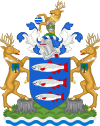Kingston Upon Thames Guildhall
History
In the early 20th century the local council was based at municipal offices in "Clattern House", a mansion which had originally been built as judges' lodgings in 1811. The Coronation Stone, which commemorates the coronation of seven Anglo-Saxon kings, was moved to its present location, which was just in front of the old mansion, in 1850. After the old municipal offices became inadequate, they were demolished to make way for the current building.

The current building, which was designed by Maurice Webb in the Neo-Georgian style, was built at a cost of £130,000. It was officially opened by Princess Alice, Countess of Athlone on 3 July 1935.
It is a neo-Georgian red brick building with Portland stone dressings and tiled roof, laid out to a semi-circular plan. To the centre of the semi-circular elevation is a massive square tower with a low octagonal spire and fluted corner pinnacles. The central entrance is in the base of the tower. Above it is a two-storey, round headed window set in an open pedimented stone niche with simplified Corinthian columns rising from a corbelled balcony. Pictorial references to the River Thames are displayed upon a keystone inside the niche, and on the corbels, capitals and iron gates. The coat of arms of Kingston is set further up the tower. Inside, there is a marble lined circular entrance hall, and a central staircase with original opaque glass semi-spherical lamps.
The building, which was established as the headquarters of the Municipal Borough of Kingston-upon-Thames, became the administrative headquarters of the enlarged Kingston upon Thames London Borough Council in 1965. In order to accommodate a larger number of staff, it was extended in 1968. It was further extended by additions known as "Guildhall one" and Guildhall two", which were designed by Ronald Ward & Partners, between 1975 and 1978.
The part of the complex associated with the magistrates' courts closed in 2011 and re-opened as a venue for weddings and civil partnership ceremonies known as the "Old Court House" in September 2015.
See also
References
- ^ Historic England. "The Guildhall, Kingston upon Thames (1080065)". National Heritage List for England. Retrieved 12 January 2017.
- ^ "London's Town Halls". Historic England. p. 138. Retrieved 25 April 2020.
- ^ Malden, H E (1911). "'Kingston-upon-Thames: Introduction and borough', in A History of the County of Surrey". London: British History Online. pp. 487–501. Retrieved 21 August 2020.
- ^ Historic England. "Coronation Stone (1080066)". National Heritage List for England. Retrieved 21 August 2020.
- ^ Hibbert, Christopher (2008). The London encyclopaedia. London: Macmillan. ISBN 978-1405049245.
- ^ "Order of proceedings for the opening ceremony, 3 July 1935". National Archives. Retrieved 21 August 2020.
- ^ "June Sampson: Guildhall to celebrate 70-year history". Surrey Comet. 12 May 2005. Retrieved 21 August 2020.
- ^ "Local Government Act 1963". Legislation.gov.uk. Retrieved 25 April 2020.
- ^ Nairn, Ian; Pevsner, Nikolaus; Cherry, Bridget (1982). Surrey (The Buildings of England). Pevsner Architectural Guides. p. 332. ISBN 9780140710212.
- ^ "Royal Borough of Kingston upon Thames, Guildhall, Kingston upon Thames". Official Journal of the European Communities. 9 November 1976. Retrieved 21 August 2020.
- ^ "About the Old Court House". Kingston upon Thames London Borough Council. Retrieved 26 August 2019.

